Part of a series of articles titled Alaska Park Science - Volume 17, Issue 1. Migration: On the Move in Alaska.
Article
Statewide Movements of Non-territorial Golden Eagles in Alaska During the Breeding Season: Information for Developing Effective Conservation Plans
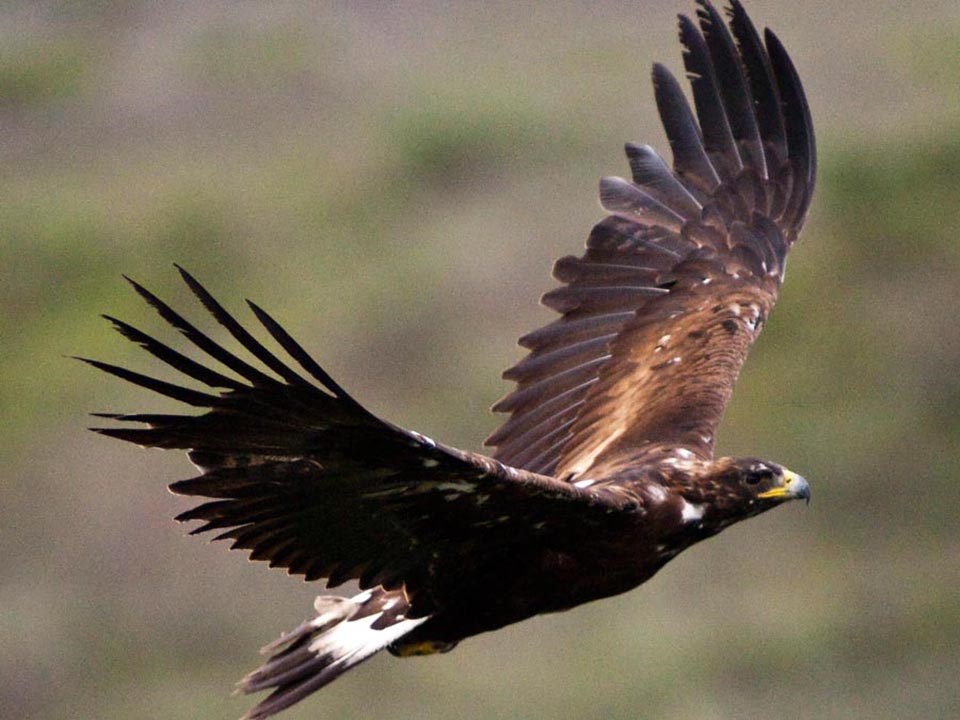
In his foundational book of 1954, The Natural Regulation of Animal Numbers, renowned ecologist Dr. David Lack (Lack 1954) stated: “In a migrant species, reproduction and the main mortality may occur in regions several hundred miles apart. This greatly complicates the study of the factors influencing numbers.” Lack’s statement exemplifies the challenges of studying the population ecology of migratory animals, but it also understates the difficulties of studying and conserving migratory species that move thousands of miles across their annual cycle. As of January 2018, 521 naturally occurring species of birds had been recorded in Alaska (Gibson et al. 2018). Many of these are international migrants that move at continental and hemispheric scales during their annual cycle. The conservation of Alaska’s migratory birds, including Golden Eagles (Aquila chrysaetos), requires identifying how events across their annual cycles influence their survival and reproduction (Sillett et al. 2000). To develop and implement effective and efficient conservation and management plans for migratory birds, National Park Service (NPS) and U.S. Fish and Wildlife Service (USFWS) managers need to know how, where, and when they travel and how conditions across their range affect their ability to survive and to produce young. However, there is limited information about the suite of conditions driving key demographic parameters of most species of migratory birds, including Golden Eagles, which nest or are raised in Alaska’s national parklands.
Effective conservation of migratory birds also requires understanding how their age and social status influence seasonal movements. This is particularly important for longer-lived species that may exhibit different behaviors and movement patterns during different stages of their life cycle. For example, during the breeding season in Alaska, the behavior and movements of Golden Eagles depend on whether or not they are part of the breeding population. Eagles that are members of the breeding population have obtained a nesting territory and are defined as territorial eagles. Territorial eagles occupy and defend nesting territories, attempt to raise young when conditions allow, and focus their movements within and near their territories during the breeding season (Figure 1). In contrast, eagles that are not members of the breeding population and have not obtained a nesting territory are defined as non-territorial eagles. Non-territorial eagles do not occupy or defend nesting territories, do not attempt to raise young, and their movements are not focused within or near their territory (Figure 1; McIntyre et al. 2008). Non-territorial eagles can be separated into two categories: individuals that are actively seeking entry into the breeding population and individuals that are not. Migratory individuals that are actively seeking entry into the breeding population usually return to Alaska about the same time as territorial eagles, from late February through March. In contrast, migratory individuals that are not actively seeking entry into the breeding population usually return to Alaska much later, from mid-April to late May.
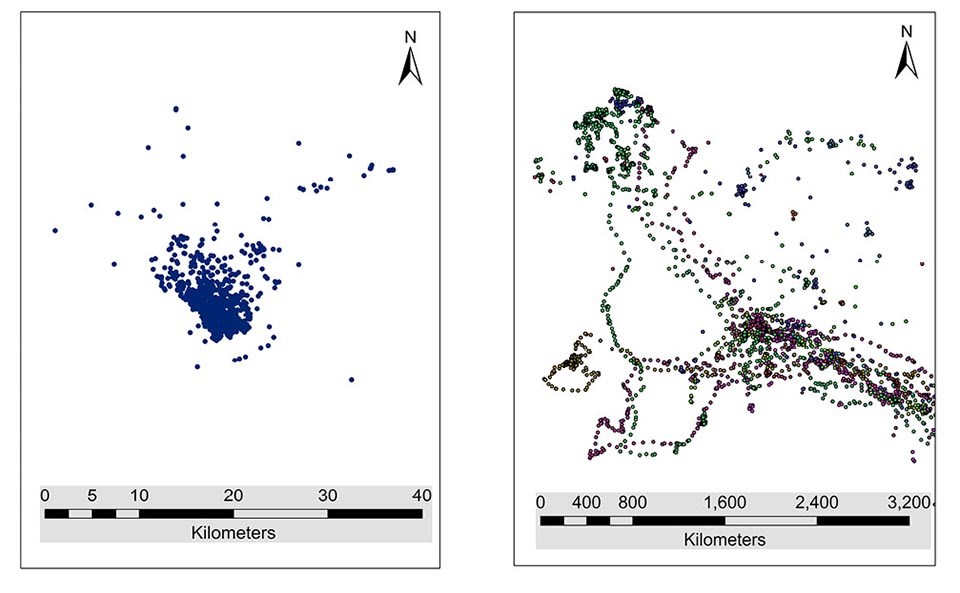
In contrast, movements of non-territorial, second- and third- year Golden Eagles, shown by relocations of 20 telemetered eagles in the right panel, are distributed across much of Alaska and portions of northwest Canada. Note scale of the map at the bottom
This article focuses primarily on second- and third-year Golden Eagles that are not actively seeking entry into the breeding population. These younger eagles represent the future generations of the breeding populations, but a large data gap exists regarding their role in population growth and stability (Watson 2010). Overall, very little is known about the natal dispersal of Golden Eagles (Watson 2010).
The classic definition of natal dispersal in birds is the dispersal from the natal nest to the site (location) of first reproduction (Greenwood and Harvey 1982). Many raptor ecologists agree that the natal dispersal stage of a Golden Eagle’s life can span many years and that many individuals may spend a substantial portion of their lives waiting for opportunities to enter the breeding population (Watson 2010). What we’ve learned is the breeding-season movements of non-territorial eagles that are not attempting to enter the breeding population are strikingly different than those of members of the breeding population and most likely from non-territorial eagles that are actively seeking entry into the breeding population. These differences in movement and resource use are important to consider when developing management and conservation plans, particularly because the needs of non-territorial eagles may be considerably different than that of territorial eagles. If conservation plans for Golden Eagles in the United States rely heavily on information based on breeding eagles or nesting territory locations (Murphy et al. 2017), it is plausible that they are not adequately addressing the needs of non-territorial eagles. Further, areas used during natal dispersal are usually unknown for most long-lived species and consequently these areas are usually less protected than breeding territories, which may lead to increased risk of mortality for the dispersing individuals (Penteriani et al. 2005).
Further, understanding the needs of non-territorial migratory Golden Eagles is important because their survival may be relatively more important for population persistence than it would be in a non-migratory population because migration may affect risk of mortality (Katzner et al. 2006). Across their range, the ecology of non-territorial Golden Eagles is not well-studied because it has been very difficult to monitor individuals over the time and space during the natal dispersal period. Some of these challenges have been overcome with the advent of lightweight telemetry tracking units.
In recent years, Golden Eagles have emerged as a conservation concern in the United States (Katzner et al. 2012, Millsap et al. 2013, Collopy et al. 2017). In response, the USFWS, the agency responsible for managing the species in the United States, has expanded their efforts to learn more about Golden Eagle ecology (USFWS 2016). Across their range, there are new concerns about the demographic resiliency of Golden Eagles (Millsap et al. 2013) particularly in relation to increases in anthropogenic sources of mortality, including habitat loss, electrocution on power distribution lines, contaminants, collisions with vehicles, and illegal shooting (Collopy et al. 2017). Overall, there is a growing need to identify management and conservation practices that reliably reduce or mitigate factors limiting the population and support management and conservation of the species at local, regional and continental scales (Collopy et al. 2017). For Alaska’s migratory Golden Eagles, this requires new studies to document their movements and sources of mortality for all age-classes across their annual cycles.
In this article, we provide some historical perspective on Denali’s Golden Eagles, highlight some of the findings from our studies of non-territorial second- and third-year Golden Eagles in Alaska during the breeding season, and use our tracking data (relocations) to demonstrate the usefulness of a landscape-scale conservation strategy for protecting and preserving Golden Eagles in Alaska.
A Bit of History about Denali’s Golden Eagles
In 2017, the NPS celebrated the 100th anniversary of the establishment of Mount McKinley National Park. This area was expanded and renamed Denali National Park and Preserve (Denali) in 1980 with the passage of the Alaska National Interest Lands Conservation Act. Denali’s centennial celebrations included recognizing the accomplishments of many of the scientists and naturalists whose efforts resulted in protecting this region and increasing awareness of its wildlife, including Golden Eagles.
Charles Sheldon, Joseph Dixon, and Adolph Murie are some of the most celebrated naturalists and scientists in Denali’s history. All three recognized that the northern foothills of the Alaska Range (now within Denali) supported a large concentration of nesting Golden Eagles (Sheldon 1930, Dixon 1938, Murie 1944, 1963). Dixon (1938:47) referred to Golden Eagles as “one of the outstanding avian citizens” of the area and recommended that the species be “preserved as an integral part of the native fauna.” Murie (1944) recognized that Denali’s Golden Eagles were migratory and understood the link between their survival and the “many new hazards in the south” (Murie 1963:3). Sheldon, Dixon, and Murie’s studies provided the inspiration to start Golden Eagle studies in Denali in 1987 (McIntyre et al. 2006a).
During the earlier years of our study (1987-1996), we banded many Golden Eagle nestlings with aluminum leg bands. The recovery of some of these eagles showed that their migration corridors and wintering areas covered a vast area of western North America (McIntyre et al. 2006a, McIntyre 2012). Further, the recovery of eagles killed by electrocution, shooting, and collisions with vehicles showed how events thousands of miles away from their protected breeding areas in Denali affected their survival (McIntyre 2012).
In 1997, we started studying the movements and survival of juvenile, second year, and third year Golden Eagles from Denali across their annual cycle. These studies were made possible by the availability of lightweight satellite telemetry tags that would allow us to track the movements of eagles across their year-round range. Using satellite telemetry, we provided some of the first estimates of survival and continental-scale movements of migratory Golden Eagles in North America (McIntyre et al. 2006b, McIntyre et al. 2008). For example, once juvenile eagles left Denali on their first autumn migration, they traveled across western North America and overwintered from the grasslands of central Alberta to the high deserts of central Mexico. These non-breeding-season movements were impressive, but not surprising since we had already recovered eagles banded in Denali in some of these areas (McIntyre 2012).
What did surprise us, and many others, were the extensive movements of the eagles when they returned to Alaska the next summer (McIntyre et al. 2008). For example, many of our radio-tagged eagles spent most of the breeding season hundreds of kilometers away from Denali, often in the Brooks Range or on Alaska’s Arctic Coastal Plain. For decades, other scientists working on a variety of wildlife species noted immature or subadult Golden Eagles in these areas (Mauer et al. 1985, Ritchie et al. 2003, Stehn 2013, Ritchie 2014, Shook and Ritchie 2017), but until our earlier telemetry studies (McIntyre et al. 2008), none of them suspected that some of the eagles they observed were raised in Denali, hundreds of miles to the south.
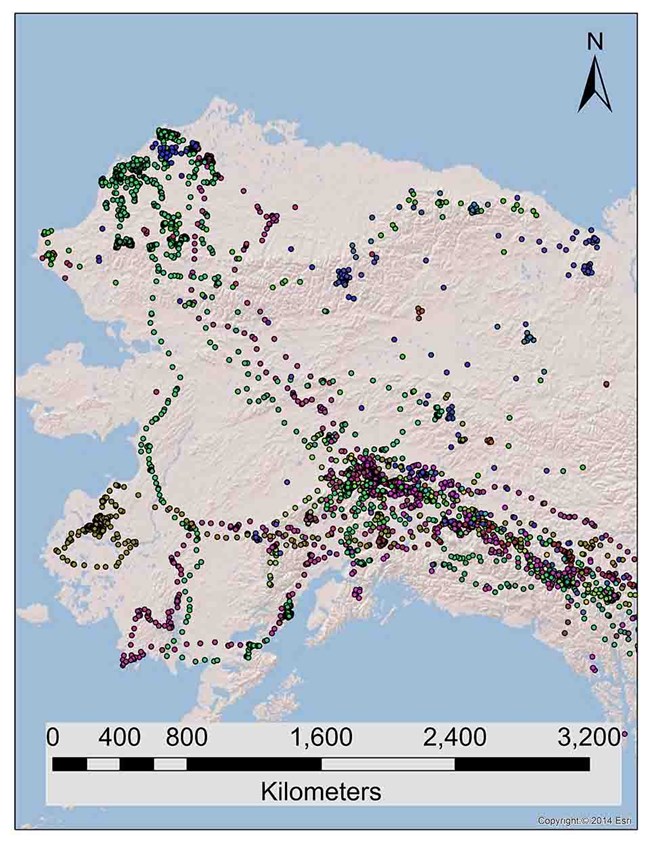
Expanding on Our Historical Studies
Our more recent tracking studies, a collaborative effort with NPS, USFWS, U.S. Geological Service, and Alaska Department of Fish and Game (McIntyre 2015), are building upon our work in the late 1990s, providing new information and reinforcing some of our earlier findings. Pooling data from deployments in the late 1990s and from 2014-2016, we noted a great deal of variation in the timing and movements of our telemetered eagles in Alaska and northern Yukon during the breeding season. Some individuals wandered for most of the breeding season, never settling in one area for very long. Others wandered extensively for part of the breeding season and then settled into a general area for extended periods of time (Figure 2).
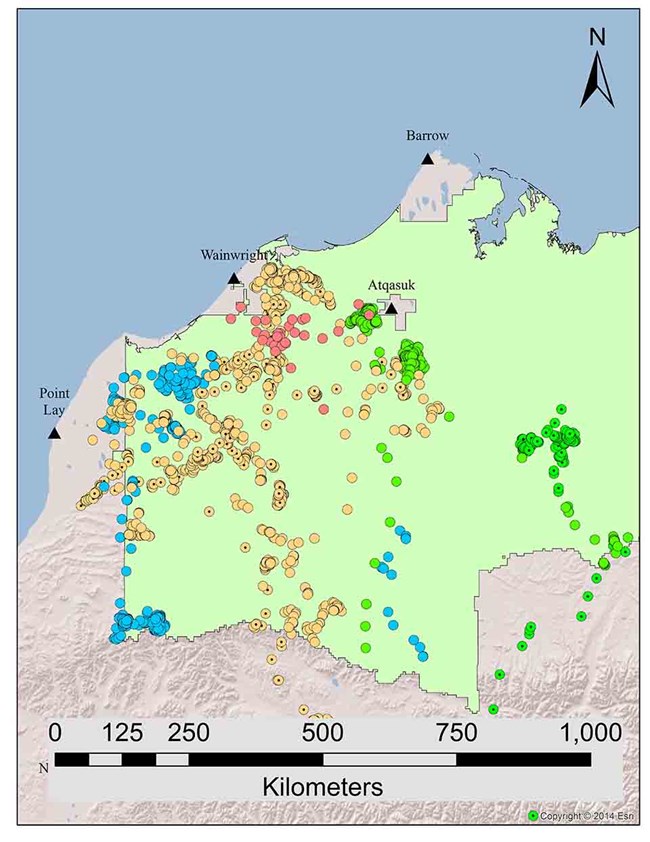
Circles with the same color but with a black dot in the center represent the same eagle in different breeding seasons.
For example, four eagles settled into areas in northwest Alaska for much of June, July, and August, including areas within the western National Petroleum Reserve-Alaska (NPR-A; Figure 3). This included eagles tagged in the late 1990s and in 2015, thus showing repeated use of this area by Denali’s Golden Eagles over a long time period.
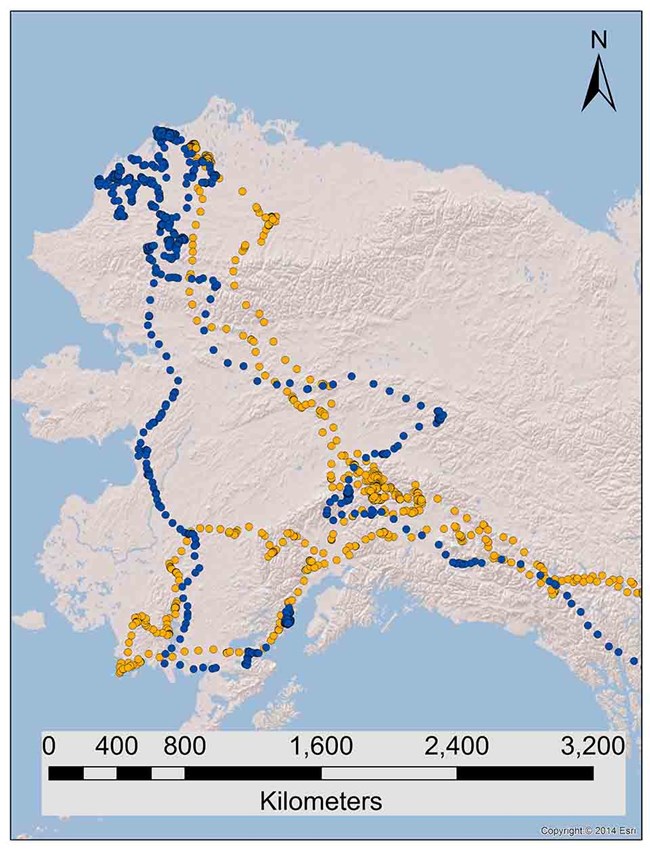
Many individuals move great distances in Alaska during the breeding season. For example, at least two individuals tagged in Denali in 2015 moved over 3,100 miles (5,000 km) each during the 2016 breeding season (Figure 4). Interestingly, these eagles were relocated in similar areas in southwestern Alaska, but during different times of the breeding season. One eagle traveled through the area in May, right after it returned to Alaska. The other traveled through the same area in September, right before it started autumn migration. Individuals also used different areas between years (Figure 5). Both eagles were located again in the NPR-A in 2015 and 2016.
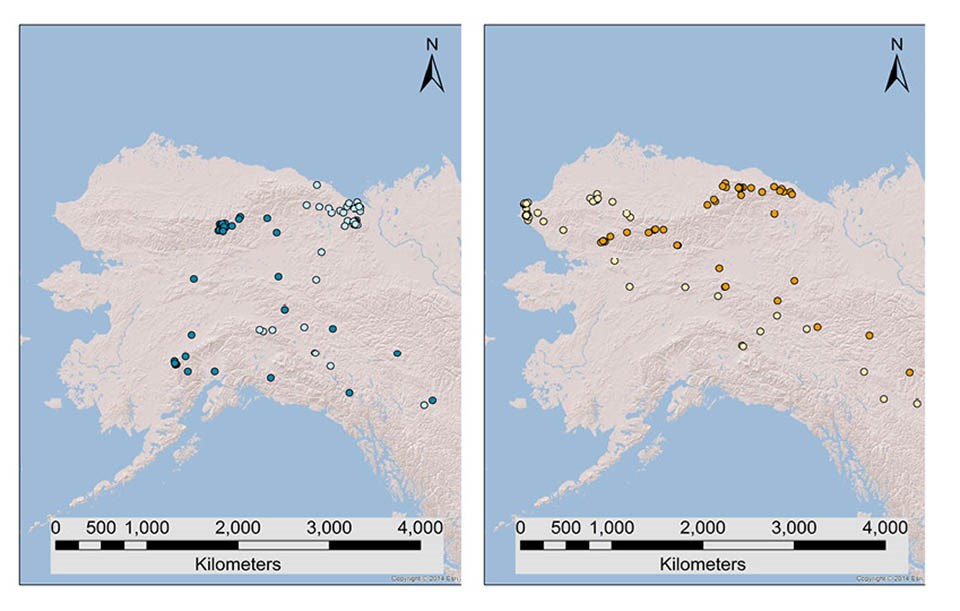
Additional Insights on Non-territorial Golden Eagles from Other Areas
We also tracked two non-territorial Golden Eagles that may have originated in natal areas outside of Denali, but who were both captured in NPS areas in Alaska. We telemetered one of the eagles along the southern slopes of the Mentasta Mountains in late March 2015 during spring migration and another near an occupied nesting territory in Denali in early April 2015. These eagles also exhibited Alaska-wide movement, spending time in places where we had not yet documented non-territorial Golden Eagles from Denali, including the Seward Peninsula in western Alaska (Figure 6).
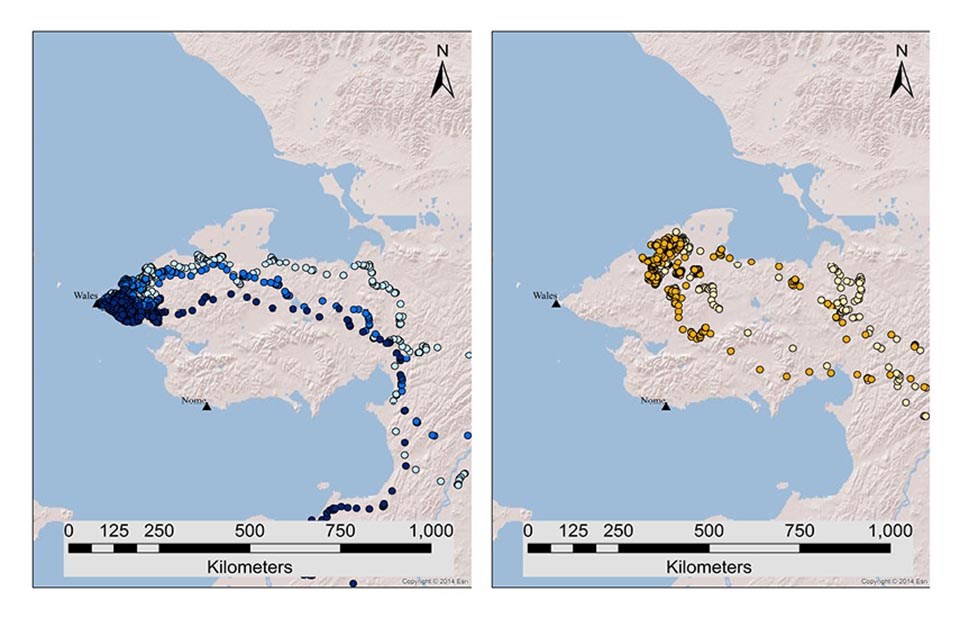
The different color circles represent different years for each eagle.
Connections with Federally Managed Areas
In addition to the NPR-A, our telemetered eagles were relocated in 27 other federally managed areas in Alaska and three federally managed areas in the Yukon during the breeding season in years after the fledging year (Table 1, Figure 7).
| Federally Managed Area |
|---|
| Admiralty Island National Monument |
| Alaska Maritime National Wildlife Refuge |
| Arctic National Wildlife Refuge |
| Bering Land Bridge National Preserve |
| Delta Wild and Scenic River |
| Denali National Park and Preserve |
| Fortymile Wild and Scenic River |
| Gates of the Arctic National Park and Preserve |
| Glacier Bay National Park and Preserve |
| Gulkana Wild and Scenic River |
| Innoko National Wildlife Refuge |
| Katmai National Park and Preserve |
| Kobuk Valley National Park |
| Lake Clark National Park and Preserve |
| National Petroleum Reserve-Alaska |
| Noatak National Preserve |
| Nowitna National Wildlife Refuge |
| Selawik National Wildlife Refuge |
| Steese National Conservation Area |
| Togiak National Wildlife Refuge |
| Tongass National Forest |
| White Mountains National Recreation Area |
| Wrangell-St. Elias National Park and Preserve |
| Yukon-Charley Rivers National Preserve |
| Yukon Delta National Wildlife Refuge |
| Yukon Flats National Wildlife Refuge |
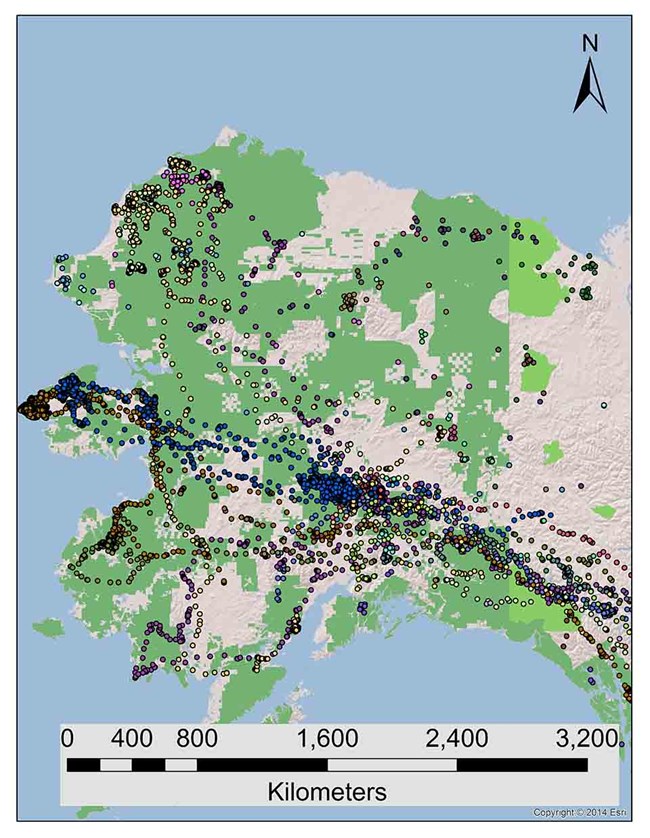
Different colored circles represent individual eagles.
Many of these lands serve as a cornerstone of conservation and management and play a critical role in maintaining biological diversity and ecosystem services (Chape et al. 2008). Individual eagles were relocated at as many as 2 to 17 federally managed areas during the breeding season (Table 2). This is not too surprising, since Alaska contains more federally managed public lands than most other states. In some cases, the eagles were moving through these areas during migration, such as the Tetlin National Wildlife Refuge (NWR), or while traveling between areas within the breeding season. Others spent extended periods of time in the breeding season in the Arctic NWR, Bering Land Bridge National Preserve, Denali National Park and Preserve, NPR-A, and the Yukon Delta NWR (Table 1 and 2). In Alaska, federally managed areas may comprise a relatively large portion of the areas used by non-territorial Golden Eagles during their extended dispersal process. This has direct conservation implications since implementing conservation actions directed toward Golden Eagles on federally managed lands may be less complicated than on private lands.
| Eaglea | Federally Managed Areas | Proportion of Relocations in Federally Managed Areas | Number of Relocations in Alaska through June 2017 |
|---|---|---|---|
| 1403 | 6 | 0.39 | 1,814 |
| 1502 | 6 | 0.26 | 5,291 |
| 1503 | 5 | 0.70 | 4,782 |
| 1505 | 6 | 0.45 | 2,901 |
| 1506 | 11 | 0.44 | 2,828 |
| 1507 | 17 | 0.52 | 2,864 |
| 1602 | 4 | 0.61 | 490 |
| 1605 | 2 | 0.11 | 467 |
| 2632 | 5 | 0.24 | 29 |
| 2635 | 6 | 0.65 | 54 |
| 2636 | 2 | 0.38 | 47 |
| 2641 | 2 | 0.26 | 19 |
| 2647 | 2 | 0.11 | 19 |
| 2657 | 2 | 0.32 | 19 |
| 2670 | 4 | 0.41 | 54 |
| 2681 | 3 | 0.10 | 69 |
| 2685 | 3 | 0.11 | 158 |
| 2689 | 2 | 0.12 | 25 |
| 2692 | 5 | 0.17 | 136 |
| 2697 | 10 | 0.38 | 136 |
Of specific interest are six eagles that spent at least part of the breeding season in the western half of the NPR-A on Alaska’s North Slope. The NPR-A is managed by the Bureau of Land Management (BLM) and is an area of increasing interest for oil and gas extraction. Four Denali eagles spent over 35% of the breeding season in the NPR-A (range 36.6-53.7%). These eagles arrived on the NPR-A from early to mid-June and remained there until late August and early September. Two others arrived in mid-June, but only remained for two to three weeks. We know of at least one other second-year Golden Eagle tagged on the wintering grounds in Montana that also spent an extended amount time in the NPR-A during the 2014 breeding season (Harmata, pers. comm., July 2014). Further, observers recorded 32, 33, and 30 Golden Eagles flying near or perched on bluffs in this area in 2012, 2013, and 2016, respectively (Shook and Ritchie 2017). In 2012 and 2013, at least 75% of these were subadult plumaged eagles and in 2016, at least 90% were subadult plumaged eagles (Shook and Ritchie 2017). While we do not yet know the fate of some of these eagles, our telemetry relocations and observations by Ritchie et al. (2003), Ritchie (2014), and Shook and Ritchie (2017) suggest that some of the NPR-A provides important resources for non-territorial Golden Eagles, including those raised in Denali. We believe that this importance should be acknowledged in conservation and management actions on the NPR-A and in statewide Golden Eagle management plans.
Statewide Movements Call for a Statewide Conservation Strategy
Every telemetered eagle tells an important, and unique, story. Our telemetry studies continue to provide new information on the movements of non-territorial Golden Eagles in Alaska during the breeding season, expanding our understanding of the ecology of this species. This information should be useful for developing effective management and conservation strategies for this species in Alaska. While limited by sample size, our studies clearly show that many second- and third-year Golden Eagles use resources across much of interior and northern Alaska during the breeding season. Thus, a statewide conservation strategy is necessary to preserve the resources needed by these eagles. While our data are restricted primarily to the eagles we tagged in Denali, our results raise interesting and important questions about the movement patterns and resource use of non-territorial Golden Eagles during the breeding season in Alaska.
Collaboration is Essential for Conservation
The dispersed movements of non-territorial Golden Eagles from Denali during the breeding season suggests that individuals are exposed to different drivers of population change across this part of their annual cycle. For example, individuals that summer in interior Alaska experience different events and conditions than those that summer in northwest Alaska. Conserving these wide-ranging eagles requires a landscape-scale approach, reaching far beyond the boundaries of Denali (Finch et al. 2017) during the breeding season and across the rest of their annual cycle. The recent emphasis on annual-cycle studies of birds (Marra et al. 2015) must be matched by the implementation of annual-cycle conservation strategies. For wide-ranging species, including Denali’s Golden Eagles and many other migratory birds, this will require close and active collaboration among all the agencies and organizations that manage the lands and resources used by these birds (Runge et al. 2014).
New Research on Golden Eagles takes Flight
We will be tracking dozens of Golden Eagles in Denali and other Alaska national parklands in the next five years as part of our ongoing collaborative studies among the NPS, USFWS, U.S. Geological Survey, and Alaska Department of Fish and Game (McIntyre 2015). The GPS-GSM telemetry units we will be using have the potential to provide data for many years because they use solar-rechargeable batteries and highly efficient software and programming (M. Lanzone, pers. comm., March 2018). This affords us new opportunities to quantify seasonal and age-specific survival, natal dispersal, lifetime reproductive success, and breeding dispersal for migratory Golden Eagles, all of which increase our ability to identify and understand factors affecting their populations. This information is critical for developing effective conservation strategies for these wide-ranging eagles.
Acknowledgments
We thank all the people who have been involved with the Denali Golden Eagle study over the years, especially Michael W. Collopy, David C. Douglas, Todd Katzner, Mike Kochert, and Karen Steenhof. We thank the National Park Service, including Denali National Park and Preserve, the U.S. Geological Survey, and the U.S. Fish and Wildlife Service for their continued support of these studies.
REFERENCES
Chape, S., M. Spalding, M. Taylor, A. Putney, N. Ishwaran, J. Thorsell, D. Blasco, J. Robertson, P. Bridgewater, J. Harrison, and E. McManus. 2008.
History, definitions, value and global perspective. Pages 1-35 in S. Chape, M. Spalding, and M. Jenkins, editors. The world’s protected areas—status, values and prospect in the 21st century. University of California Press, Los Angeles, California, USA.
Collopy, M. W., B. Woodbridge, and J. L. Brown. 2017.
Golden Eagles in a changing world. Journal of Raptor Research 51:193-196.
Dixon, J. S. 1938.
Fauna of the National Parks of the United States. Birds and mammals of Mt. McKinley National Park. Fauna Series No. 3. U.S. Government Printing Office. Washington, D.C.
Finch, T., S. J. Butler, A. M. A. Franco, and W. Cresswell. 2017.
Low migratory connectivity is common in long-distance migrant birds. Journal of Animal Ecology 86: 662-673.
Gibson, D. D., L. H. DeCicco, R. E. Gill, Jr., S. C. Heinl, A. J. Lang, T. G. Tobish, Jr., and J. J. Withrow. 2018.
Checklist of Alaska Birds, 24th edition–2018. University of Alaska Museum, Fairbanks, AK.
Greenwood, P. J. and P. H. Harvey. 1982.
The natal and breeding dispersal of birds. Annual Review of Ecology and Systematics 13: 1-21.
Katzner, T., B. W. Smith, T. A. Miller, D. Brandes, J. Cooper, M. Lanzone, D. Brauning, C. Farmer, S. Harding, D. E. Kramar, C. Koppie, C. Maisonneuve, M. Martell, E. K. Mojica, C. Todd, J. A. Tremblay, M. Wheeler, D. F. Brinker, T. E. Chubbs, R. Gubler, K. O’Malley, S. Mehus, B. Porter, R. P. Brooks, B. D. Wyatts, and K. L. Bildstein. 2012.
Status, biology and conservation priorities for North America’s Eastern Golden Eagles (Aquila chrysaetos) population. Auk 129:168-176.
Katzner, T. E., E. A Bragin, and E. J. Milner-Gulland. 2006.
Modelling populations of long-lived birds of prey for conservation: A study of imperial eagles (Aquila heliacal) in Kazakhstan. Biological Conservation 132: 322-335.
Lack, D. 1954.
The Natural Regulation of Animal Numbers. Oxford Press.
Marra, P. P., E. B. Cohen, S. R. Loss, J. E. Rutter, and C. M. Tonra. 2015.
A call for full annual cycle research in animal ecology. Biology Letters 11, 20150552.
Mauer, F. 1985.
Distribution and relative abundance of Golden Eagles in relation to the Porcupine Caribou herd calving and post-calving periods, 1984. Page 114-144 In Arctic National Wildlife Refuge Coastal Plain Resource Assessment, 1984 Update Report Baseline Study of the Fish, Wildlife and their Habitats, Volume I, Section 1002C, Alaska National Interest Lands Conservation Act. U.S.D.I, U.S. Fish and Wildlife Service, Region 7, Anchorage, Alaska.
McIntyre, C. 2015.
Conserving migratory Golden Eagles in a rapidly changing world. Alaska Park Science 14(2).
McIntyre, C. L. 2012.
Quantifying sources of mortality and wintering ranges of Golden Eagles from interior Alaska using banding and satellite tracking. Journal of Raptor Research 46:129-134.
McIntyre, C. L., D. C. Douglas, and M. W. Collopy. 2008.
Movements of Golden Eagles (Aquila chrysaetos) from interior Alaska during their first year of independence. Auk 125: 214-224.
McIntyre, C., K. Steenhof, M. N. Kochert, and M. W. Collopy. 2006a.
Long-term Golden Eagle studies in Denali National Park and Preserve. Alaska Park Science 5:42-45.
McIntyre, C. L., M. W. Collopy, and M. S. Lindberg. 2006b.
Survival probability and mortality of migratory juvenile Golden Eagles from interior Alaska. Journal of Wildlife Management 70:717-722.
Millsap, B. A., G. S. Zimmerman, J. R. Sauer, R. M. Nielson, M. Otto, E. Bjerre, and R. Murphy. 2013.
Golden Eagle population trends in the western United States: 1968-2010. Journal of Wildlife Management 77: 1436-1488.
Murie, A. 1963.
The Birds of Mt. McKinley, Mt. McKinley Natural History Association. Mt. McKinley, Alaska.
Murie, A. 1944.
The Wolves of Mt. McKinley. Mt. McKinley Natural History Association. Mt. McKinley, Alaska.
Murphy, R. K., J. R. Dunk, B. Woodbridge, D. W. Stahlecker, D. W. LePlante, B. A. Millsap, and K. V. Jacobson. 2017.
First-year dispersal of Golden Eagles from natal areas in the southwestern United States and implications for second year settling. Journal of Raptor Research 51: 216-233.
Penteriani, V., F. Oralora, and M. Ferrer. 2005.
Floater survival affects population persistence. The role of availability and environmental stochasticity. Oikos 108: 523-534.
Ritchie, B. 2014.
Raptor surveys at lakes in the Foothill-Coastal Plain Transition, Colville to Kuk Rivers, NPR-A, Alaska, July 2012 and 2013. Unpublished report. ABR, Inc., Fairbanks, Alaska and Bureau of Land Management, Fairbanks, Alaska.
Ritchie, R. J., A. M. Wildman, and D. A. Yokel. 2003.
Aerial surveys of cliff nesting raptors in the National Petroleum Reserve-Alaska, 1999, with comparisons to 1977. Technical Note 413, U.S.D.I., Bureau of Land Management, Fairbanks, Alaska.
Runge, C. A., T. G. Martin, H. P. Possingham, S. G. Wills, and R. A. Fuller. 2014.
Conserving mobile species. Frontiers in Ecology and Environment 12: 395-402.
Sheldon, C. 1930.
Wilderness of Denali. Charles Scribner’s Sons. Chicago, Illinois.
Shook, J. E. and R. J. Ritchie. 2017.
Raptor surveys at lakes in the Foothill-Coastal Plain Transition, Colville to Kuk Rivers, NPR-A, Alaska, July 2016. Unpublished report. ABR, Inc., Fairbanks, Alaska and Bureau of Land Management, Fairbanks, Alaska.
Stehn, R. A. 2013.
Analysis of aerial survey indices monitoring waterbird populations of the Arctic Coastal Plain, Alaska, 1986-2012. Unpublished report. USFWS, Migratory Bird Management, Anchorage, Alaska.
Sillett, T. S., R. T. Holmes, and T. W. Sherry. 2000.
Impact of global climate cycle on population dynamics of a migratory songbird. Science 288: 2040-2041.
U.S. Fish and Wildlife Service. 2016.
Bald and Golden Eagles: Population demographics and estimation of sustainable take in the United States, 2016 update. Division of Migratory Bird Management, Washington, D.C., USA.
Watson, J. 2010.
The Golden Eagle. T&AD Poyser, London.
Last updated: November 3, 2022
